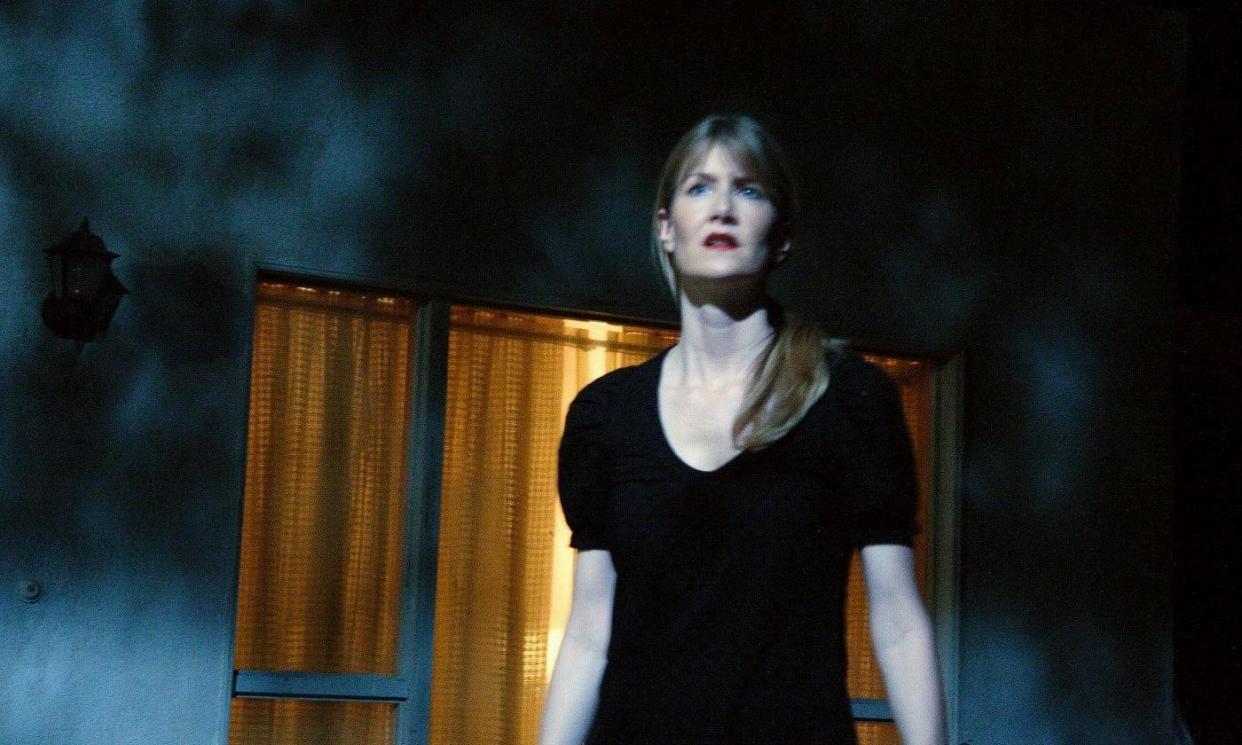Inland Empire review – David Lynch’s fascinatingly unwholesome altered-states horror

The great eroto-surrealist David Lynch has gone truffling for another imaginary orifice of pleasure, with results that are fascinating, sometimes very unwholesome, and always enjoyable. His new film can best be described as a supernatural mystery thriller - with the word “mystery” in 72-point bold. A Hollywood star called Nikki Grace, played with indestructible poise and intelligence by Laura Dern, accepts the heroine’s role in an intense southern drama about adultery and murder, working with a roguishly handsome leading man (Justin Theroux) and an elegant British director (Jeremy Irons). But to her bafflement and then terrified dismay, Nikki discovers that the script is a remake of a lost, uncompleted Polish film, and that the project is cursed. The original lead actors died, as did the poor devils in the folk tale of fear on which it was based.
Acting out the role, in its new Americanised setting, is a seance of evil and horror. One of the rooms on the set turns out to be a portal into an infinite warren of altered states: Nikki finds herself in the first Polish film, or maybe it is that Polish characters and producers from that film are turning up in the second film, or in her real life, which sometimes turns out to be a scene from the film and sometimes something else entirely. There is a disquieting chorus of LA hookers, and often we come out into an imaginary sitcom featuring a braying laugh-track and characters dressed as rabbits. Curiouser and curiousest.
The nightmare goes on and on - for three hours, in fact. But believe me when I say that, though this is familiar Lynch stuff, it is never dull, and I was often buttock-clenchingly afraid of what was going to happen next and squeaking with anxiety. The opening scene, in which Nikki is visited by a creepy neighbour (Grace Zabriskie) is so disturbing, I found myself gnawing at a hangnail like a deranged terrier.
The epic length of Inland Empire is perhaps explained by the freedom afforded by the cheaper digital medium, with which the director is working for the first time, handling the camera himself. Unlike the plasma TV screens in Dixon’s, David Lynch is evidently not HD-ready; this is ordinary digital video we’re talking about, with all its occasional gloominess and muddiness, and for which the director is compensating by using many big, almost convex closeups. Vast fleshy features loom out of the grainy fog.
Chief among these is Laura Dern’s wonderful face: equine and gaunt, sometimes, but always lovely and compelling in a way that goes quite beyond the cliche of “jolie laide”. It is either radiant or haunted, and in one terrible sequence transformed into a horror mask that is superimposed on to the male face of her tormentor. These searing images made me think that Lynch is still inadequately celebrated as a director of women, with a sensitivity somewhere between Almodóvar’s empathy and Hitchcock’s beady-eyed obsession.
Inland Empire is, as with so many of Lynch’s movies, a meditation on the unacknowledged and unnoticed strangeness of Hollywood and movie-making in general, though I am bound to say that it does not have anything like Naomi Watts’s marvellous “audition” scenes in Mulholland Drive. The director’s connoisseurship of Hollywood, his anthropologist eye for its alien rites, are however as keen as ever.
Lynch is entranced by the straight movie-making world: he loves the stars on the Hollywood Walk of Fame – something awful happens here on Dorothy Lamour’s star – the rehearsals, the shooting, the cutting and printing and checking the gate, and he loves the spectacle of actors walking contemplatively beside enormous sound-stages, for all the world as if they are in Singin’ in the Rain. Yet he finds something exotic and bizarre in it; these qualities are not superimposed on normality, however; he finds the exoticism and bizarreness that were there all along.
Because watching movies is a bizarre business, and a movie creates its own world, in some ways more persuasively cogent and real than the reality surrounding it, Lynch positions himself in the no man’s land between these two realities and furnishes it with a landscape and topography all his own. Nobody else brings out so effectively the hum of weirdness in hotel furniture, in Dralon carpeting and in smouldering cigarette butts in abandoned ashtrays. His music and sound design, with echoes and groans, are insidiously creepy, though only once does he gives us the signature Lynch motif: the slow vibrato on an electric guitar chord.
He establishes a bizarre series of worm-holes between the worlds of myth, movies and reality, with many “hole” images and references, which culminate horribly, and unforgettably, in a speech from a homeless Japanese woman over Nikki’s prostrate body about a prostitute who dies on account of a “hole in her vagina wall leading to the intestine”. It is a gruesome but gripping image of how the vast, dysfunctional anatomy of David Lynch’s imaginary universe is breaking down and contaminating itself. This gigantic collapse is perhaps the point, and the film-versus-reality trope is simply the peg on which to hang a gigantic spectacle of anarchy with no purpose other than to disorientate. It is mad and chaotic and exasperating and often makes no sense: but actually not quite as confusing as has been reported. Even the most garbled of moments fit approximately into the vague scheme of things, and those that don’t - those worrying rabbits - are, I guess, just part of the collateral damage occasioned by Lynch’s assault on the ordinary world. How boring the cinema would be without David Lynch, and for a long, long moment, how dull reality always seems after a Lynch movie has finished.
• Inland Empire is re-released on 26 May in UK cinemas.

 Yahoo Movies
Yahoo Movies 
